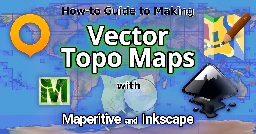Search
How do I make an office appear on OpenCycleMap?
How do I make an office appear on OpenCycleMap?
The local representation of the German Cyclists' Association has an entry on OpenStreetMap and has tools and an air pump for cyclists on site. We would like the association to appear on OpenCycleMap as well. For this purpose, both service:bicycle:pump=yes and service:bicycle:repair=yes have been set for the node. It's been more than a week since the according changes were made - unfortunately I still can't see the location in OpenCycleMap. Any ideas what to do? \#OpenCycleMap #OpenStreetMap
Guide to make vector topo maps with JOSM and Inkscape (infinitely scaleable paper wall maps)
Make Vector Topographic Maps (Open Street Map, Maperitive, and Inkscape)
by Michael Altfield
This guide will show you how to generate vector-based topopgraphic maps, for printing very large & high-quality paper wall maps using inkscape. All of the tools used in this guide are free (as in beer).
| [!How-to Guide to Making Vector Topo Maps with Maperitive and Inkscape](https://tech.michaelaltfield.net/2024/10/01/osm-contours-svg-maperitive/) | |:--:| | How-to Guide to Making Vector Topo Maps with Maperitive and Inkscape |
Intro
I recently volunteered at a Biological Research Station located on the eastern slopes of the Andes mountains. If the skies were clear (which is almost never, as it\'s a cloud forest), you would have a great view overlooking the Amazon Rainforest below.
| [!Photo of a lush green, mountainous forest. In the background is a glacial-covered summit.](https://tech.michaelaltfield.net/2024/10/01/osm-contours-svg-maperitive/) | |:--:| | Yanayacu is in a cloud forest on the east slopes of the Andes mountains, just 30 km from the summit of the glacial-capped Antisana volcano (source) |
The field station was many years old with some permanent structures and a network of established trails that meandered towards the border of Antisana National Park -- a protected area rich with biodiversity that attracts biologists from around the world. At the top of the park is a glacial-capped volcano with a summit at 5,753 meters.
Surprisingly, though Estacion Biologicia Yanayacu was over 30 years old, nobody ever prepared a proper map of their trails. And certainly there was no high-resolution topographical map of the area to be found at the Station.
That was my task: to generate maps that we could bring to a local print shop to print-out huge 1-3 meter topographical maps.
And if you want to print massive posters that don\'t look terrible, you\'re going to be working with vector graphics. However, most of the tools that I found for browsing Open Street Map data that included contour lines couldn\'t export an SVG. And the tools I found that could export an SVG, couldn\'t export contour lines.
It took me several days to figure out how to render a topographical map and export it as an SVG. This article will explain how, so you can produce a vector-based topographical map in about half a day of work.
Assumptions
This guide was written in 2024, and it uses the following software and versions:
- Debian 12 (bookworm)
- OsmAnd\~ v4.7.10
- JOSM v18646
- Maperitive v2.4.3
- Inkscape v1.2.2
The Tools
Unfortunately, there\'s no all-in-one app that will let you just load a slippy map, zoom-in, draw a box, and hit \"export as SVG\". We\'ll be using a few different tools to meet our needs.
| [!OsmAnd](https://tech.michaelaltfield.net/2024/10/01/osm-contours-svg-maperitive/) | |:--:| | OsmAnd |
OsmAnd
OsmAnd is a mobile app.
We\'ll be using OsmAnd to walk around on the trails and generate GPX files (which contain a set of GPS coordinates and some metadata). We\'ll use these coordinates to generate vector lines of a trail overlaying the topographic map.
If you just want a topographic map without trails (or your trails are already marked on OSM data), then you won\'t need this tool.
In this guide we\'ll be using OsmAnd, but you an also use other apps \-- such as Organic Maps, Maps.me, or Gaia.
| [!JOSM](https://tech.michaelaltfield.net/2024/10/01/osm-contours-svg-maperitive/) | |:--:| | JOSM |
JOSM
JOSM is a java-based tool for editing Open Street Map data.
We\'ll be using JOSM to upload the paths of our trails (recorded GPX files from OsmAnd) and also to download additional data (rivers, national park boundary line, road to the trailhead, etc). We\'ll then be able to combine all of this data into a larger GPX file, which will eventually become vector lines overlaying the topographic map.
You can skip this if you just want contour lines without things like rivers, roads, trails, buildings, and park borders.
View Finder Panoramas
Have you ever wondered how you can zoom-in almost anywhere in the world and see contour lines? I always thought that this was the result of some herculean effort of surveyors scaling mountains and descending canyons the world-over. But, no \-- it\'s a product of the US Space Shuttle program.
In the year 2000, an international program called SRTM (Shuttle Radar Topography Mission) was launched into space with the Endaevor Space Shuttle. It consisted of a special radar system tethered to the shuttle with a 60 meter mast as it orbited the earth.
| [!Artist rendering shows a space shuttle with a purple beam emanating from it to a blue, cloudy sphere below. Attached to the shuttle is a long mast with a device at the end of it, where another purple beam emanates down to the same point on Earth, at a different angle.](https://tech.michaelaltfield.net/2024/10/01/osm-contours-svg-maperitive/) | |:--:| | This illustration shows the Space Shuttle Endeavour orbiting \~233 kilometers above Earth. The two anternae, one located in the Shuttle bay and the other located on a 60-meter mast, were able to penetrate clouds, obtaining 3-dimentional topographic images of the world\'s surface (source: NASA) |
When the shuttle returned to earth, the majority of our planet\'s contours were mapped. This data was placed on the public domain. Today, it is the main data source for elevation data in most maps.
While the data from SRTM was a huge boon to cartographers, it did have some gaps. Namely: elevation data was missing in very tall mountains and very low canyons. Subsequent work was done to fill-in these gaps. One particular source that ingested the SRTM data, completed its gaps, and made the results public is Jonathan de Ferranti\'s viewfinderpanoramas.org.
We will be downloading .hgt files from View Finder Panoramas in order to generate vector contour lines for our topographical map.
| [!Maperitive](https://tech.michaelaltfield.net/2024/10/01/osm-contours-svg-maperitive/) | |:--:| | Maperitive |
Maperitive
Maperitive is a closed-source .NET-based mapping software (which runs fine in Linux with mono).
We\'ll be using Maperitive to tie together our GPX tracks, generate contour lines, generate hillshades, and export it all as a SVG.
| [!Inkscape](https://tech.michaelaltfield.net/2024/10/01/osm-contours-svg-maperitive/) | |:--:| | Inkscape |
Inkscape
Inkscape is a cross-platform app for artists working with vector graphics.
We\'ll be using inkscape to make some final touches to our vector image, such as hiding some paths, changing their stroke color/shape/thickness, and adding/moving text labels. Finally, we\'ll use inkscape to export a gigantic, high-definition .png raster image (to send to the print shop).
Guide
To read the full guide on how to create vector-based maps, click here:
Example Maps
For example, here\'s the (A4-sized) topo map that I built for Yanayacu.
| [!Image shows a topographical map of a mountainous area. The title reads \"Yanayacu\". The elevation ranges from 2,100 to 2,900. The bottom-left has a small font that reads \"Map by Michael Altfield / github.com/maltfield/yanayacu\"](https://tech.michaelaltfield.net/2024/10/01/osm-contours-svg-maperitive/) | |:--:| | Final (raster) export, ready for sending to the print shop (source svg) |
Note that I changed the stroke and thickness of the National Park boundary to be large and green, I changed the path of the road (downloaded from OSM data in JOSM) to be thick and black, and I changed my GPX tracks (recorded in OsmAnd and merged with the OSM data in JOSM) to be thin, dashed, and red.
The source .svg file for the above image can be found here
I also used this method to generate a simplified \"trail map\" of Yanayacu (without contour lines). The workflow was similar, except I didn\'t generate contour nor hillshades layers in Maperitive before exporting as a .svg
| [!Image shows a \"trail guide\" map. The title reads \"Yanayacu Trails 2024\". The bottom-left has a small font that reads \"Map by Michael Altfield / github.com/maltfield/yanayacu\")](https://tech.michaelaltfield.net/2024/10/01/osm-contours-svg-maperitive/) | |:--:| | Yanayacu Trail Guide (source svg) |
The source .svg file for the above image can be found here
@lemmy.ml
made my first #opendata contributions to @[email protected] yesterday. Pull request dopamine AND alternative reality game dopamine? Sign me up
(#foss @organicmaps is terrific both at navigation and mapping)
Current altitude is off


I am using a fresh osmand install, and now I have this widget on the right showing the wrong altitude. Always about 50m too high. The bottom widget shows the correct altitude however, that is kinda weird. I have updated the app now, but same thing.
Using f-droid latest version, but this happened also with the one I had before (4.85). I am also using brouter plugin for navigation, maybe the correct altitude comes from there idk. The wrong one is also displayed when in the default profile with no brouter involved.
Anybody else seeing this phenomenon?
Oh and the "centre map" altitude doesn't seem to be working at all, but I don't need that anyway.
A while ago I've seen a before-after screenshot command line tool for osm mentioned somewhere but I cannot find it anymore.
@openstreetmap A while ago I've seen a before-after screenshot command line tool for osm mentioned somewhere but I cannot find it anymore. I believe it was written in python. Does anyone know the name of the tool in question?
Edit: Thanks to @richlv , this is it: https://github.com/amandasaurus/osm-mapping-party-before-after
Project for people leaving Google Maps.

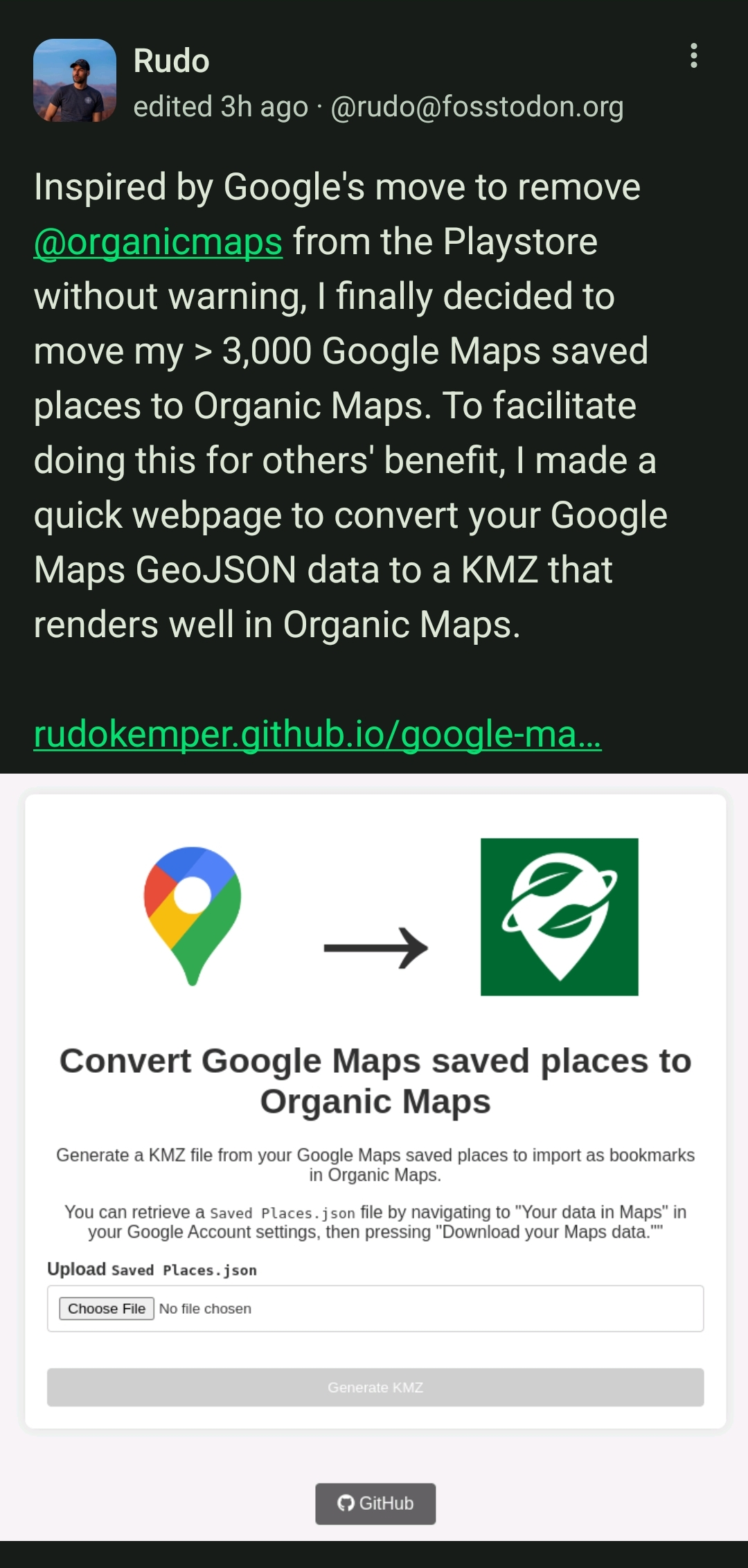
cross-posted from: https://feddit.org/post/2989211
> Mastodon Toot. > > Project.
What's up with Overture Maps?
When I read about Overture Maps like a year or 2 ago, it seemed to me that basically they were going to create a whole new thing from scratch.
Let's be honest, with enough resources, it's easy to see that they could pull off some kind of OpenStreetMap 2.0, where all the issues from OSM are modernised and cleaned up.
What's really going on? Are we getting something soon from these people? What's the relationship with them?
On their website, they say "coming this fall". Are you excited? Scared? What should I think?
Preferred way to map landuse=residential?
I've encountered some conflicting usages of Tag:landuse=residential. Some areas are very specific, and broken down into individual blocks, while some areas cover multiple blocks. Here's an example of both styles adjacent to each other:
https://www.openstreetmap.org/way/653823458
https://www.openstreetmap.org/way/652122607
The wiki doesn't really say much on the topic. Does anyone have opinions/rules of thumb on how to tag them exactly? It seems like all adjacent areas not separated by major highways should be joined together?
I've encountered some residential areas that are broken down into mapping each block, and literally follow the curb, rounded corners and all. That seems too specific?
How should sidewalk crossings be mapped exactly?
I'm looking at Tag:crossing=marked, and it's a little vague. It says:
> Set a node on the highway where the transition is and add highway=crossing + crossing=marked. > > If the crossing is also mapped as a way, tag it as highway=footway footway=crossing crossing=marked or highway=cycleway cycleway=crossing crossing=marked as appropriate.
Doesn't that violate the principle of One feature, one OSM element? For example, here's a crossing from where overpass-turbo defaults to showing:
https://www.openstreetmap.org/node/7780814396
https://www.openstreetmap.org/way/833493479
You've got a way with these tags:
crossing=marked crossing:markings=yes footway=crossing highway=footway surface=asphalt
And the intersection node with the street it's crossing has these tags:
crossing=marked crossing:markings=yes highway=crossing tactile_paving=no
Shouldn't that be one or the other? It makes sense to me to represent the crossing as a way with all the tags, and leave the intersection untagged. I noticed though that StreetComplete doesn't really like that, and will give you quests to add tags to the intersection node even if the way is properly tagged.
Large-Scale Generation of Transit Maps from OpenStreetMap Data
Some really cool transit map generation from OSM data. There's an online demo you can play with here.
I'm always surprised how poor legibility the most used digital map has
One shows only a few shops, often the ones that pay the most, the other shows the true number of different places in the area.
Is there any documentation on mapping individual small plants like flowers or cacti?
@openstreetmap Is there any documentation on mapping individual small plants like flowers or cacti? I'd like to start mapping botanical gardens but cannot find any information on this.
Das Atomium in #Brüssel, gerendert in #cgeo auf der 3D #OpenStreetMap #Freizeitkarte sieht lustig aus.

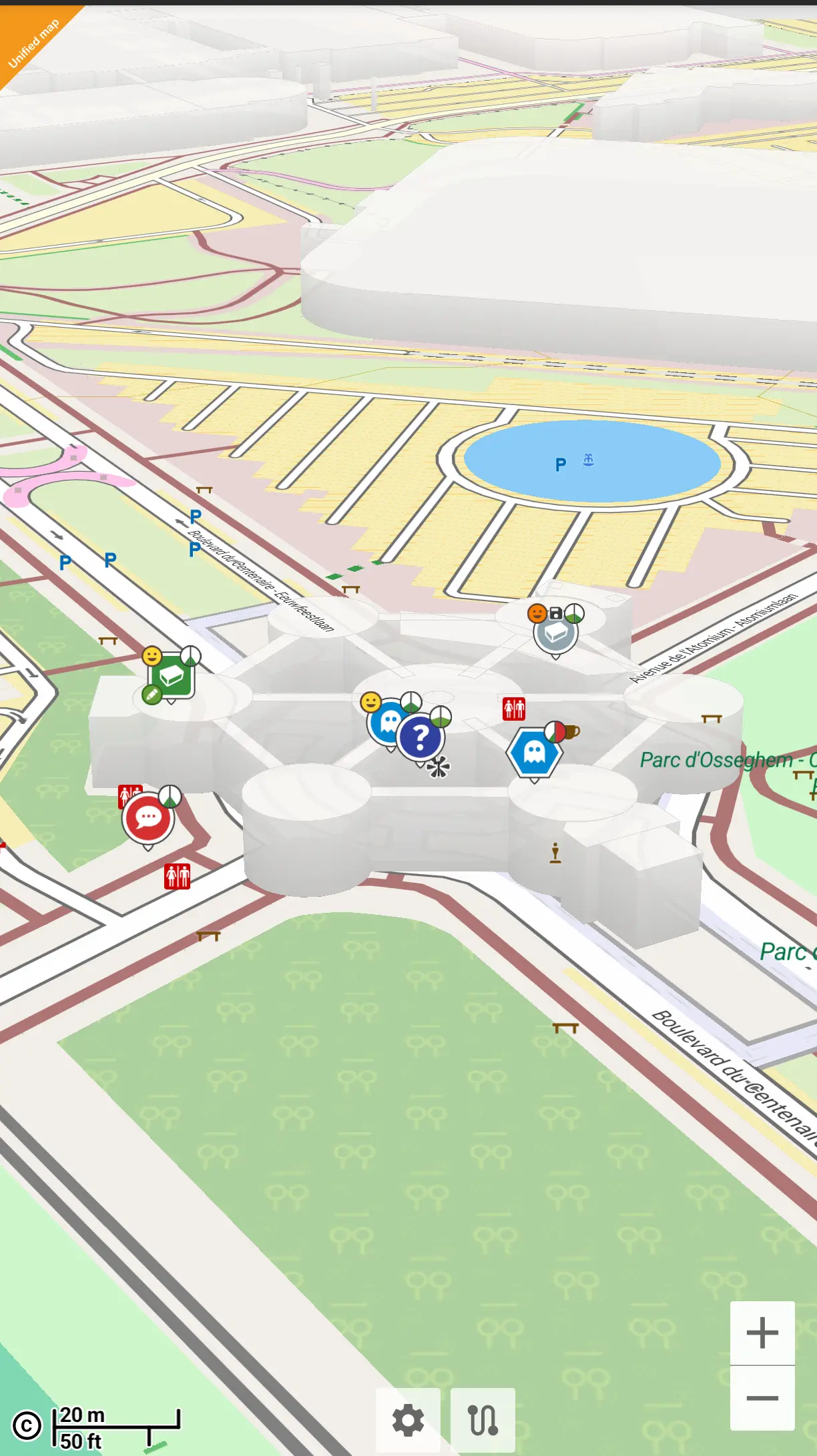
Das Atomium in #Brüssel, gerendert in #cgeo auf der 3D #OpenStreetMap #Freizeitkarte sieht lustig aus.
OSM: Where zoos look like zoos
Attached: 2 images Glad to see the great job @[email protected] and @[email protected] are doing. For cycling to the zoo's main entrance, where I can buy entry, they suggest a sensible route. #Google maps seems to suggest I go through the zoo, possibly via the tiger cage. #OSM #Op...
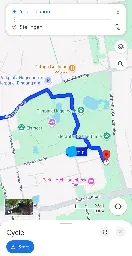
>Henry@[email protected] > > Glad to see the great job @openstreetmap and @organicmaps are doing. For cycling to the zoo's main entrance, where I can buy entry, they suggest a sensible route. #Google maps seems to suggest I go through the zoo, possibly via the tiger cage. > >https://social.lol/@hl/113047359789803891
>Dawid Rejowski@[email protected] > >@hl @openstreetmap @organicmaps > >Also somehow ZOO looks more like a ZOO. > >Here I needed a while to understand what is that place. Only after reading the labels I understood it is the center of Warsaw, a place that should be one of the most recognizable places in Poland.\ >Compared to OragnicMaps, with rich colors, colorful Metro icons, building shapes and rails, Google Maps looks very blended. > >https://101010.pl/@didek/113050389244877936
Can I use a Relation to join a restaurant and its patio?
I've got a patio for a restaurant tagged as leisure=outdoor_seating. That page says you can add operator=* as a string, but I'm wondering if I can add a Relation between the patio and the restaurant. This is really for semantic reasons, because if the restaurant changes its name or gets a new owner, it would be nice if the patio didn't then have out-of-date information.
I don't see a Relation type that's relevant. I don't want to just start doing my own thing, so does anyone know of a way to use a Relation here, and if not, is that something that can be proposed?
Thanks for all of the responses on my other questions, btw. This community has been very helpful.
What value should I use for traffic_signals=*?
I'm looking to tag a simple 4 way stop with typical US red/yellow/green traffic signals. I was wondering what the difference between signal and traffic_lights is in iD, and the wiki page just says this about traffic_lights:
> A typical traffic signal. This value was the second most common value as of 2021-09-15 despite being undocumented until that point.
Looking at the talk page there, it links to this post, where an iD dev seems rather annoyed at the wiki:
> I took a look at https://wiki.openstreetmap.org/wiki/Key:traffic_signals and now I'm furious. > > Forget it. > > There is no way I'm going to support traffic_signals=yes for pedestrian signals, after the wiki folks aren't even ok with iD using traffic_signals=signal for a normal traffic signal - a tagging that was accepted just not very widespread before iD started doing it. > > The OSM Wiki needs to end. Seriously. It's ruining this project.
I'm using iD, so should I just leave it as the default signals and leave the fighting up to the devs? As an aside, does anyone know why there seems to be so much animosity there? Kind of surprising TBH
What is the best way to mark an inactive bus stop?
I've encountered a bus stop that still exists, but has a sign from the city saying that no busses stop there. There's the disused tag on the wiki which seems relevant, but I'm not sure how to tag it exactly. There's lots of tags like ref, route_ref, operator:wikidata and so on. Should all of those tags get prefixed with disused:?
was ist denn heute mit #Openstreetmap los? Läd das nur bei mir nicht bzw. nicht richtig?
was ist denn heute mit #Openstreetmap los? Läd das nur bei mir nicht bzw. nicht richtig?
What's going on with #Openstreetmap today? Is it just me that it's not loading or not loading properly?
Sanity check on kerb and lit tags
Hello! I've just started using StreetComplete, and I want to make sure I understand the answers before I go through and make a bunch of garbage data.
In this picture, is the kerb a ramp, or flush?
The sidewalk deflects downwards, but it's not a ramp ramp like the example picture.
How about this one?
The kerb itself dips, but the sidewalk on this one looks more flat and does simply run into the road. And then it has the texture, obviously. Is this one different from the last one?
Also, just to check, I marked both of these sidewalks as "concrete". That's correct, right? I wondered about "concrete plate", because they're segmented, but the picture made concrete plate look much more substantial.
My other question was based on the "lit" tag for a bus stop. This bus stop has a street light near it, but there's no light on the bus stop itself. It sounds like that means it is lit? Would a non-lit stop just be one that is fully dark at night, then, with no kind of lighting anywhere near it at all?
This one is further from the street light, but still has line of sight. Lit?
Thanks very much for any help you have!
Street-Complete, like Pokemon Go but for good.

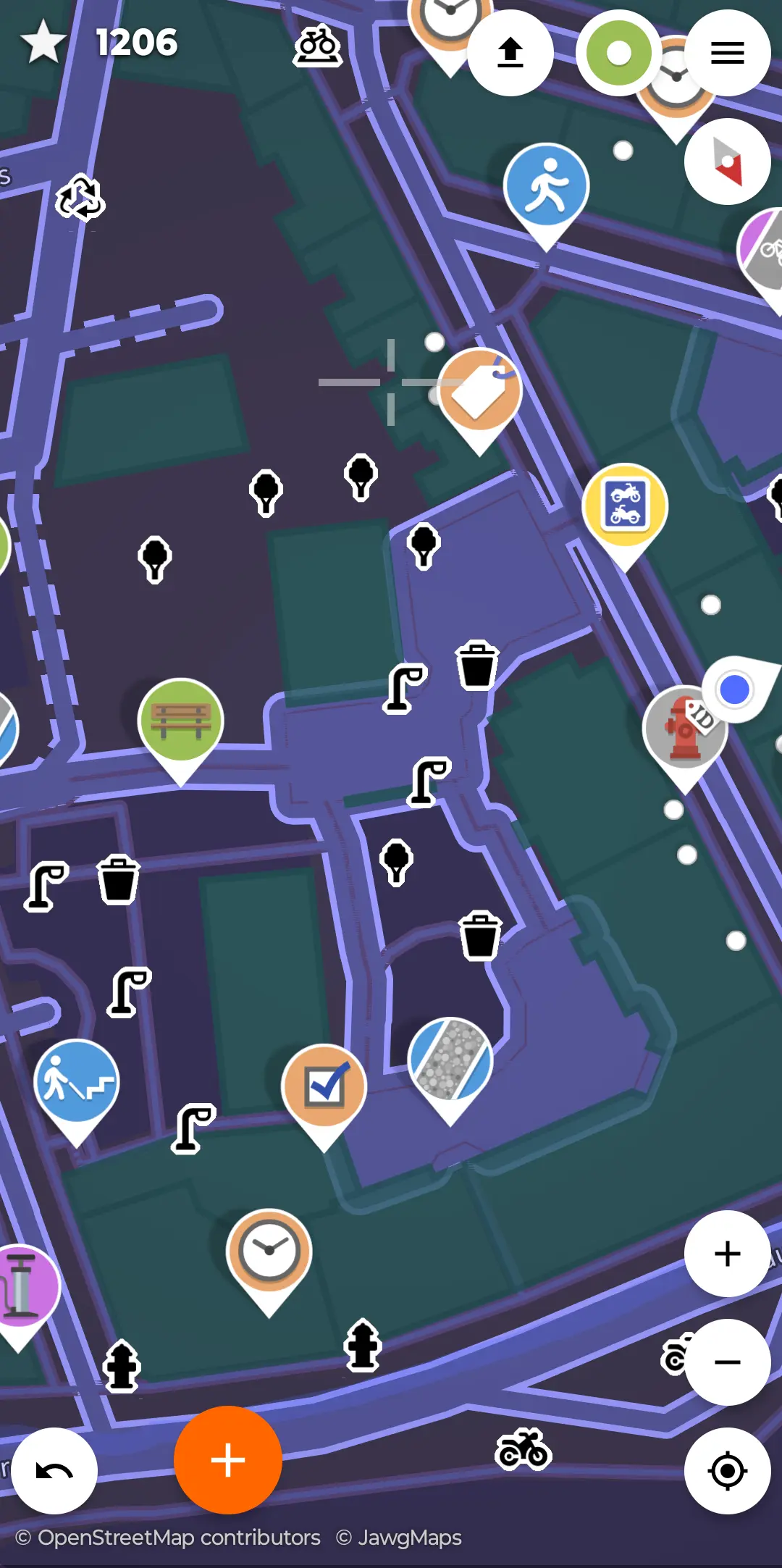
I first learned of Street-Complete here and I really like it.
It's satisfying to walk around, complete little tasks, and get prizes, scratching a similar itch to Pokemon Go.
Stuck waiting for someone? Add opening hours for a few local businesses.
Have a long walk ahead of you? See if you can add/check house addresses as fast as you can walk.
Want to walk off a few beers before heading home? Complete some tasks in the bar street.
Its a very constructive way to "be right" on the internet.
As I understand it, concrete plates, at least in the UK, tend to be quite big, like the road here:
You might find though that pavements / sidewalks are made up of smaller plates, as they're easier to transport and fit, rather than waiting for a large area of concrete to set. The only paths that I can think of right now that are concrete are on private property, so I can't link to them. They're things like garden paths and are continuous.
If you're not sure though, you can always tag as surface=concrete and let someone else add any extra detail in the future. At least then the basics are there :)
I was also confused. I've been using concrete:plates for almost all walkways that I've encountered. On surface=concrete:plates it says this:
surface=concrete - concrete forming a large surface, typically cast in place and may have predetermined breaking joints
Which is confusing, because sidewalks AFAIK are cast in place and have predetermined breaking joints, but it seems like surface=concrete is more for mostly continuous concrete surfaces regardless of that text?
I can’t remember the name of which lets you choose profiles based on your mode of transport.
BRouter Web maybe?
Google maps uses gtfs, public transport companies publish that feeds. Osm does not store this data, only subsets were imported, mostly the physical stuff, stops, stations and sometimes lines.
For proper public transport routing you need a service where this feeds were imported or linked correctly, and they can combine it with osm data for alternatives.
I used this osm based app a long time ago, I don't know if it's still working: https://transportr.app/
@oliver @openstreetmap In addition to an update frequency of weekly at best, I have no idea if those #OpenStreetMap tags are actually used by #OpenCycleMap compared with more explicit ones. Best ask @gravitystorm himself (creator of OCM)
@RubberElectrons @strubbl Yes, we are a fun group! No, sadly nothing in the US (yet!)
@RubberElectrons @strubbl
I don't know if @geomob are running anything in the US these days. @OpenStreetMapUS might have events that interest you?
@infeeeee @openstreetmap
Yes I was.
In the current state they are useless for showing the images, but it might be better to keep them temporarily and use the changeset information to contact the original 'uploader' and see if they'd be willing to upload via e.g. @MapComplete (who have a @panoramax instance now).
iD should not be allowing the creation of these so I think someone should open a bug report if it isn't already fixed.
@infeeeee @lukstru @openstreetmap
That looks like something that should work in an HTML <img > tag, but doesn't. Maybe it has been truncated?
OSM is database, not a website and it does not store pictures, only links to them. 1
The most well supported way would be to upload the images to wikimedia commons, create a category for each spot there, and than add the category name to the wikimedia_commons tag on the element in osm.
- Tag documentation: https://wiki.openstreetmap.org/wiki/Key:wikimedia_commons
- General info on Wikimedia Commons connection: https://wiki.openstreetmap.org/wiki/Wikimedia_Commons
Renderer support:
- OsmAnd can display these images, in the section "Online photos" in the detailed view of an element
- Organic Maps adds a Wikimedia Commons button, which opens the category in the webbrowser
- On openstreetmap.org these links are clickable.
- Wiki lists some more renderers supporting this tag: https://wiki.openstreetmap.org/wiki/Key:wikimedia_commons#Support
Another common tag for this is the image tag, you can just link there a single image. https://wiki.openstreetmap.org/wiki/Key:image
Mapillary is a google streetview alternative owned by Meta/Facebook. It has it's own tag and you can link there images uploaded to mapillary. Note: this platform is not fully GDPR compliant, and owned by a terrible company, so I personally don't recommend contributing there, just it's a common option. https://wiki.openstreetmap.org/wiki/Key:mapillary
1: Except those strange guys who store base64 encoded images in the image tag, taginfo link, but it should be only really low resolution as there is an 255 character limit for values. I haven't found a renderer which could display this.
As mappers we can link OSM objects to images, but the images themselves must be hosted elsewhere because OSM is not an image hosting service. You can upload the images of your parkour landmarks to wikimedia commons, flickr, or really any image hosting service, then update the tags for the POIs in OSM.
As for saving the POIs, most apps that use OSM have favorites or bookmarks, for example, I know OsmAnd does, and I’d bet Organic Maps does, too. I know OsmAnd also has a way of displaying the images linked to a POI, so what you’d do is bookmark your parkour landmarks in an app like OsmAnd, then you should be good to go.
@maltfield @palitu
As I understand it Maeritive does a decent OSM based map really easily.
QGIS can only do it after a tonne of work.
@[email protected] @[email protected] @organicmaps
@amapanda I think we even mapped the same place at some point :)
@uninvitedguest @shoobs ooh, I didn't realise there was source available
Is Loom the resulting tool? Unfortunately I'm lacking the mental bandwidth to read through the whole paper.
@anonymous111 mind sharing your map?
I know the author has already mentioned it, but MapComplete.org might be a good site to look at if you're just starting and have local knowledge of an area. I know in my early days mapping that just looking at a list of map features would remind me about places that I've know about forever and never thought to put on a map. The MapComplete themes might have some obvious omissions that you can fix quickly.
